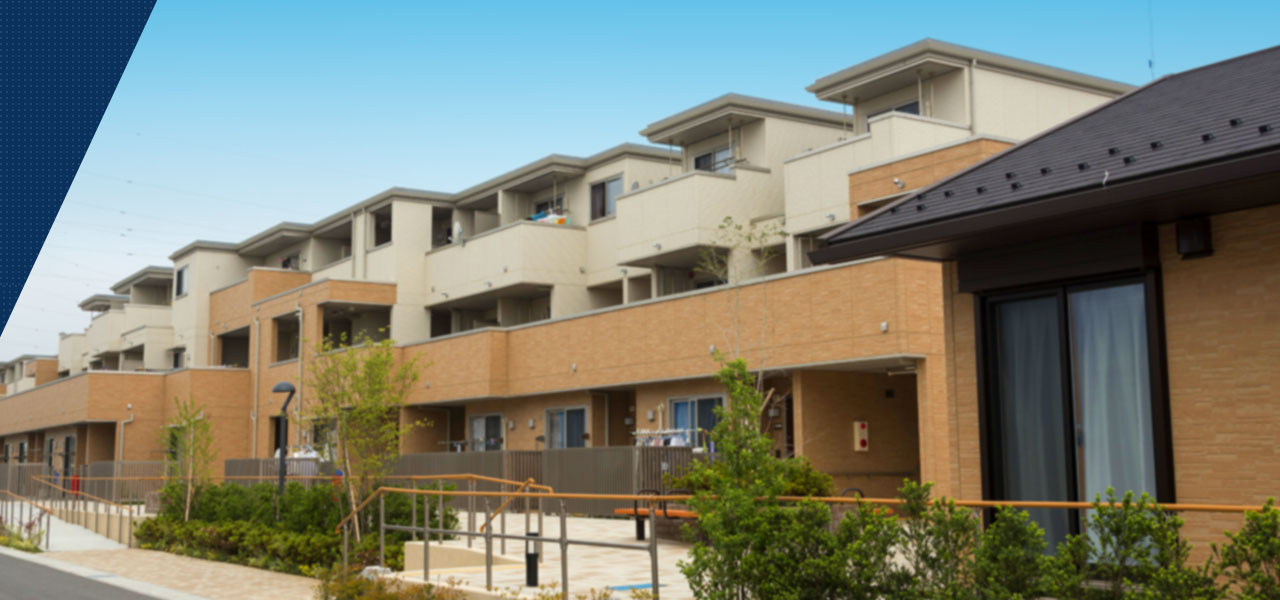
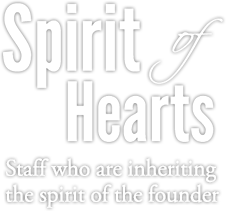
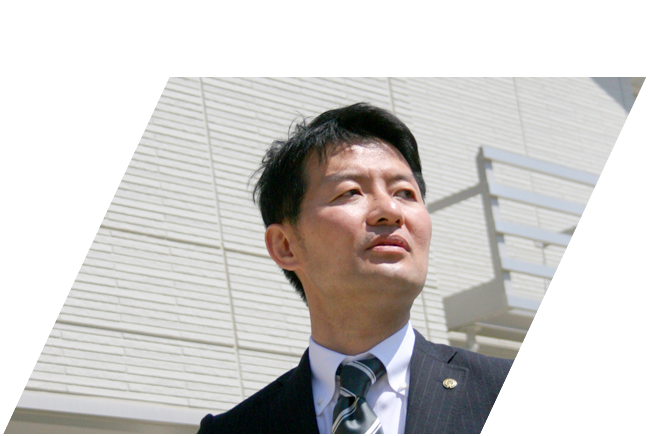

"Doing our best to support
post-disaster reconstruction"
To help people who lost their homes in the 2011 earthquake and tsunami,we at Daiwa House speeded up our provision of post-disaster public housing.This was in line with the corporate DNA established by our founder. We aim to reestablish safe and comfortable lives for the people of these communities as swiftly as possible.

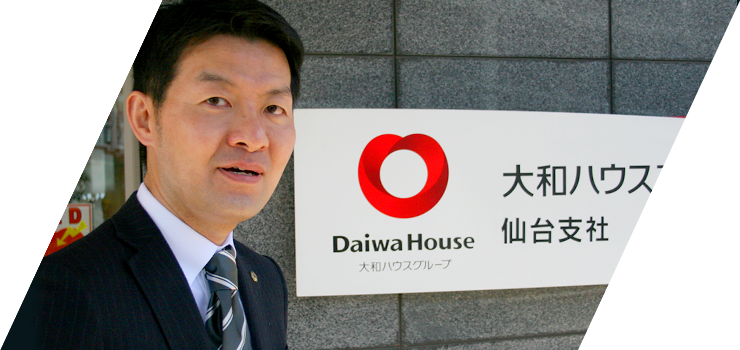
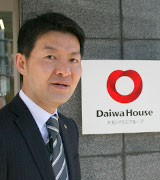
![]()
![]()
![]()
![]()
![]()
![]()
![]()
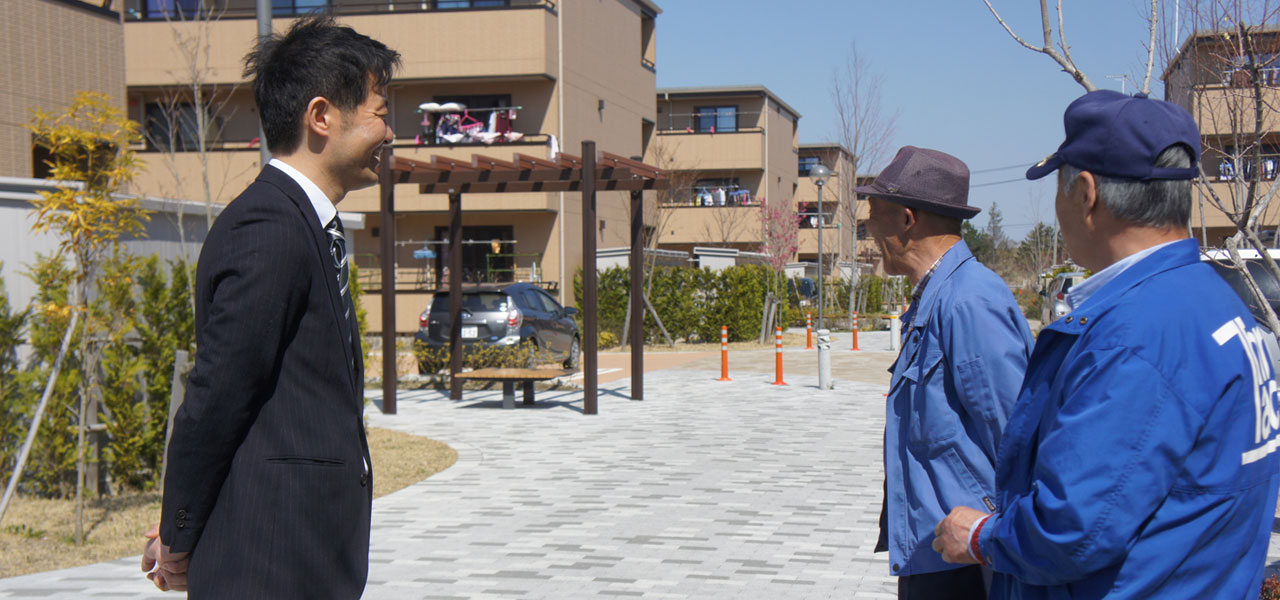
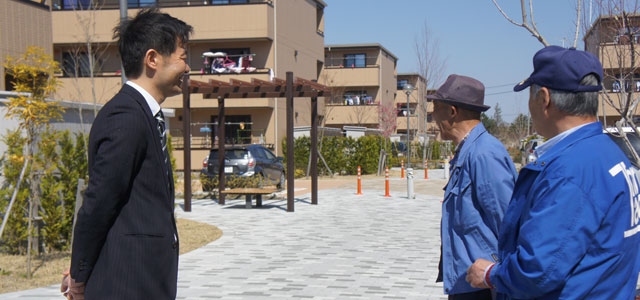

From temporary housing to permanent homes
One day in spring, just when the cherry blossoms were in full bloom, Hiroyuki Ishii, then working at the Reconstruction Support Office in Sendai, found himself in the city of Higashi-Matsushima, also in Miyagi Prefecture. Mr. Ishii, whose job was in housing design, had been touring various sites where public housing – being supplied as part of post-disaster reconstruction efforts – had been erected. Encountering some of the residents of the temporary housing, he greeted them cheerily: "Good afternoon! It's rather windy today, isn't it?" And then he ventured to ask them what they thought about living there. Five years had already passed since he had been hastily reassigned to Fukushima from the Daiwa House Head Office in Osaka, only two months after the massive earthquake and tsunami had struck Japan's Tohoku region on March 11, 2011.
At that time, most of the residents who had lost their homes in the disaster were still sleeping in school gymnasiums and other public facilities, and were desperate to move into emergency temporary housing as soon as possible. Responding to these strong desires, Mr. Ishii and his colleagues working in design and construction were working every day from dawn until late at night. Hiroyuki Ishii himself had been transferred to this district to provide technical assistance. His work was severely hindered by a lack of materials and parts, and on many days, to enable other staff to complete the manufacture of components he had designed in the morning, he would spend the afternoons making the rounds of home centers and materials wholesalers, trying to scrape together an adequate amount of materials, and then go back to the drawing board at night.
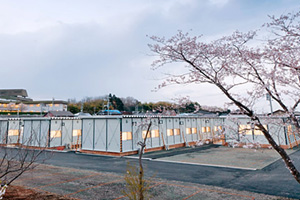
Emergency temporary housing in Natori, Miyagi Prefecture, provided by Daiwa House
Even after he had been reassigned to the Head Office, Mr. Ishii made frequent further trips back to the Tohoku Region, and when all the emergency temporary housing had finally been completed and handed over, his boss asked him to go back for a further three months to assist the local staff. What was needed now was the sort of post-disaster public housing that — for many residents — would be their final home. Mr. Ishii had spent many years working on the development of apartment housing, and here was an opportunity for him to show what he could do in his area of specialty.
On the other hand, once he was back in Sendai, far from his family, he looked at the desolate landscape that stretched before his eyes and realized how seriously he had underestimated the challenge. "Never mind three months! This could take ten years!" But he made up his mind that the job had to be done, and got ready for the long haul.
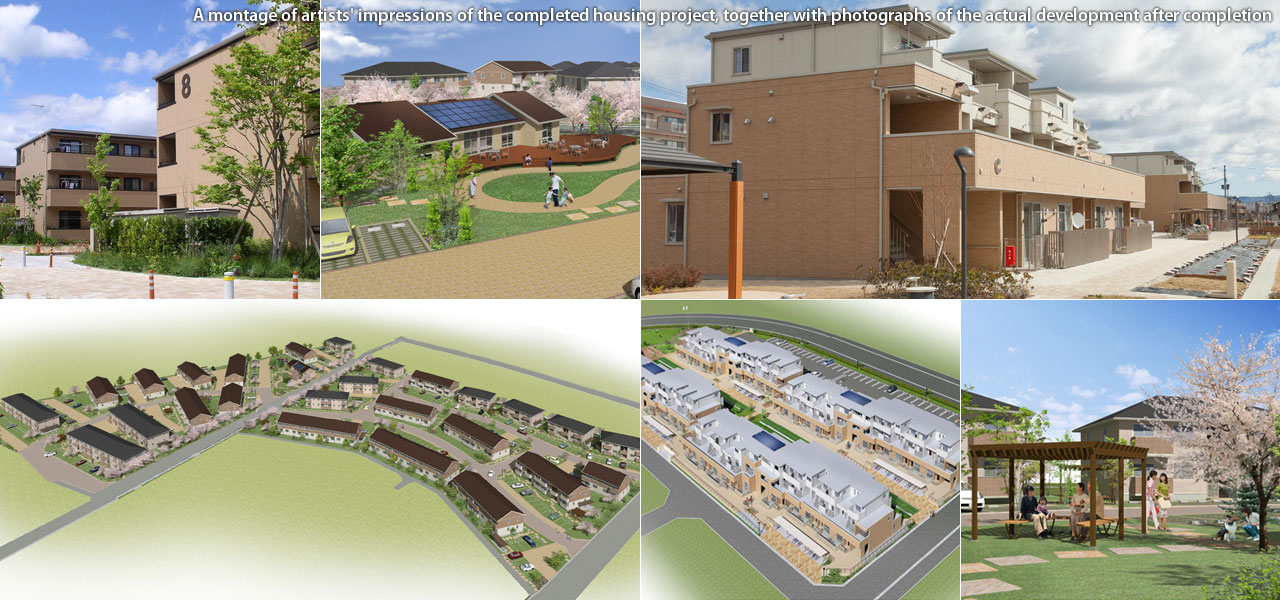
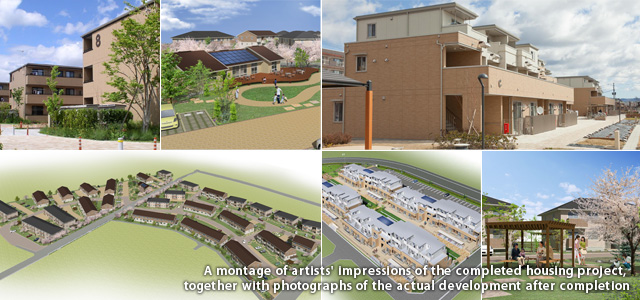

Strongly held convictions will win the day
Our Reconstruction Support Office in Sendai was established in 2012. From this base, Hiroyuki Ishii and his fellow staff members set to work to draw up and present proposals for post-disaster public housing to the various local governments. However, the majority of public housing up until then had been built with reinforced concrete or wooden structural frameworks, and Daiwa House's proposal to use lightweight steel structures — which are our specialty — was rejected on the grounds that there was no precedent.
Why were the advantages of the method we proposed not recognized, in spite of the fact that the use of such lightweight steel frameworks, manufactured in factories all over Japan, would enable the erection of high-quality housing in a short time? Mr. Ishii and his colleagues were so tired and disappointed that they almost became discouraged, but fortunately they held firm to their belief in the superiority of the Daiwa House method. "Daiwa House is a company that had helped solve Japan's severe postwar housing shortage through the development of prefabricated homes — a company that had come through many difficult trials." With such thoughts echoing in their minds, they were certain that the spirit of our founder, who insisted above all that the Company should be of service to society, would win through in the end.
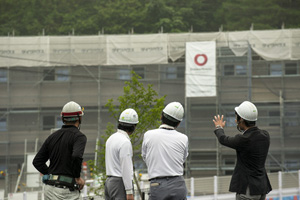
The post-disaster public housing project under construction
As for the local governments, they experienced great difficulty in acquiring sites for construction of the needed housing. In addition, there was a shortage of construction materials and workers, and a long backlog in the entire conventional bidding process for selection of companies to carry out each stage of the necessary work, including land preparation, architectural design, and construction. These factors greatly delayed the reconstruction project.
This is where the strengths of Daiwa House came into play. Our local staff had spent many years building up close relationships with landowners in the region, and were able to set in motion an integrated process from land acquisition through preparation to construction and town planning. Mr. Ishii and his colleagues proposed a new scheme to the local government involved, whereby Daiwa House and other private companies would acquire the land and build the housing units, which the local governments would then purchase.
Despite enormous difficulty in getting this new concept accepted, Daiwa House was finally able to complete construction of the first post-disaster public housing for one municipality, and this attracted the attention of other local governments.Following this successful debut, this new model for public housing creation, in which private companies acquire the land and build the structures required, and then sell them to the local authorities, became rapidly accepted throughout the disaster-hit region. At the end of the day, the conviction — strongly held by Hiroyuki Ishii and his fellow staff members — that the value of the system developed by Daiwa House would be recognized, proved to be true.
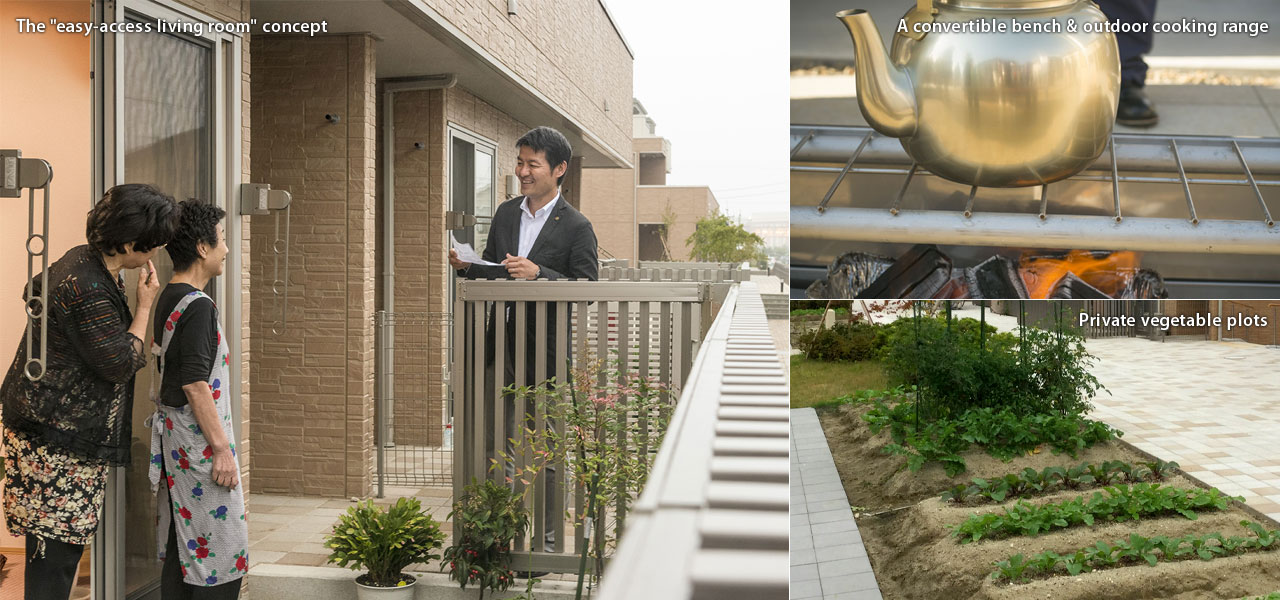
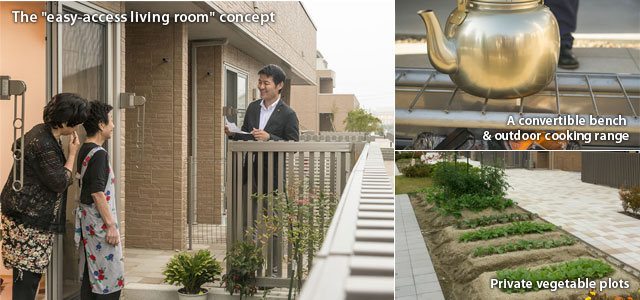

Beyond design work
The Komatsu-Minami housing development in Higashi-Matsushima City, Miyagi Prefecture was the first post-disaster public housing project on which Hiroyuki Ishii worked. Because the project was undertaken immediately after the disaster, when the housing shortage was particularly acute, speed was of the essence. Naturally, it was also essential that the housing be strongly earthquake-resistant and very durable, but if these qualities were pursued to the exclusion of others, we would probably have ended up with the box-like homes that are all too common.
But all the personnel involved in this project were keen to create a path-breaking model that would showcase the potential of prefabricated home-building methods. For this reason, they put in painstaking work on the specifications – right down to the most minute details – as well as on the exteriors and even the greenery to be planted. Mr. Ishii collaborated with Mr. Suzuki of the Design Section – who was an expert in exteriors and had been worrying about post-completion maintenance – to produce a manual, and on being asked whether there were subcontractors capable of doing the job, he went out and found them. Refusing to settle for less than the best, he repeatedly negotiated with all parties concerned to secure a comfortable and happy life for the homeless victims of this disaster.
In a design competition for the Shintateno post-disaster housing project in the city of Ishinomaki (also in Miyagi Prefecture), Mr. Ishii often held animated discussions late into the night with his supervisor Mr. Hashimoto and design staff. The result of all these efforts was the birth of the "easy-access living room" concept – an idea aimed at encouraging communication among the residents of the project.
The unique feature of this was that the living rooms of each housing unit would be situated on the same side of the home as the pathway for use by all residents (the opposite alignment from the normal one in Japan). This arrangement encourages residents to strike up informal, impromptu conversations with one another as they pass by on their way to and from their housing units. Other features of the development include a private vegetable plot for each home unit, and outdoor cooking ranges built into convertible benches, which are principally for use in the event of an earthquake or other natural disaster, but can also be used for barbecues.
Mr. Ishii and his colleagues wanted to directly explain to the residents the ideas that had gone into the design of each residential space and piece of equipment, and so they arranged various community support events after handing over the project to the local government. These included workshops on growing one's own vegetables, and outdoor food-tasting parties.
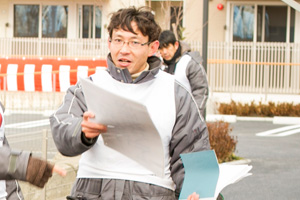
Koichi Suzuki, responsible for exteriors
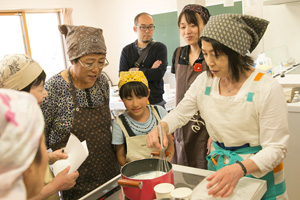
A cookery class at the housing development's meeting-place
In a series of workshops, Mr. Ishii and his fellow employees are currently cooperating with prospective residents of a post-disaster housing project now under construction – as well as with the neighbors living in existing homes nearby – to decide the purposes of a planned "community square." He believes that, even when the work that Daiwa House has been contracted to do is completed, it will be his duty to meet the people involved face-to-face, so that he can discuss with them how to improve their day-to-day lives. As a matter of fact, it is not just Mr. Ishii's busy schedule as a designer that has made him into the kind of person he is – a certain vividly memorable experience lies in the background.
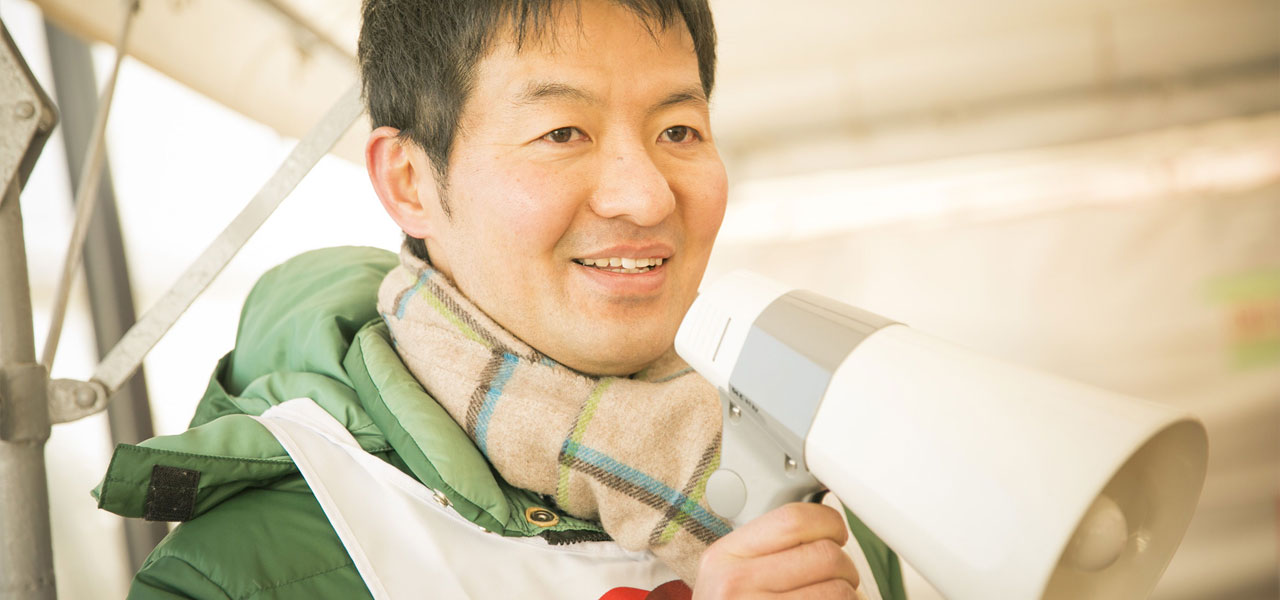
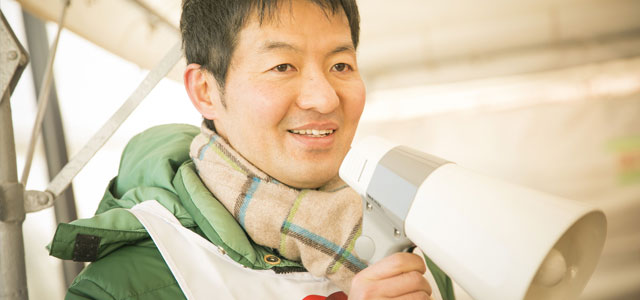

A shiver of joy
When the Sakaeda post-disaster housing development in Ishinomaki was completed, Mr. Ishii and Mr. Endo of the CSR Support Section at the company's Sendai Branch planned a traditional mochi-maki event, which would follow an explanatory session for the residents. As a way of helping integrate the residents into their new community, they also visited the heads of the local neighborhood associations at their homes, and invited residents of existing housing nearby to attend the ceremony. Mr. Ishii mobilized his staff despite their busy schedules, and introduced them one by one to the residents. "Let me introduce Mr. Ohtake, one of the designers of this housing development, and Mr. Okamura, who was in charge of construction."
The entirely unexpected response from the audience was vigorous applause accompanied by shouts of appreciation. "Well done!" they shouted. "Thank you … thank you!" On hearing these heartfelt cries of gratitude and happiness, Mr. Ishii felt a shiver of joy run down his spine. The eyes of the other staff members, too, shone with strong emotion.
Hiroyuki Ishii has walked together with the victims of the March 2011 disaster along the road to recovery. Many times had he listened to the heartrending stories of these survivors who had lost their homes and their loved ones, and who, even when they had finally moved into their new homes, found themselves all alone. This is why he had had no choice but to involve himself in supporting the development of a new community. All his efforts had been aimed at putting a smile on the faces of the residents.
Hiroyuki Ishii couldn't wait to tell all his colleagues at Daiwa House about the happiness that shone in the faces of the people who had moved into their new homes, and about the words of deeply felt gratitude he had received. Many Daiwa House employees had been involved in the work of providing post-disaster public housing, and Mr. Ishii, for his part, also felt grateful to all those others who had worked alongside him and provided him and his staff with the essential support. These people include not only those of the design, marketing, construction, and land development and preparation divisions of Daiwa House's Tohoku District, but also all those staff members who worked on component layout design and room partitioning, as well as the staff of the Group's research centers and manufacturing plants, and those who worked on product development, CSR, and after-sales service, as well as the staff of general affairs sections. As he says: "I am very grateful to my fellow Daiwa House employees all over Japan, who provided invaluable support for us, helping us rise to the challenge of building post-disaster public housing."
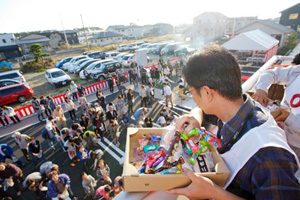
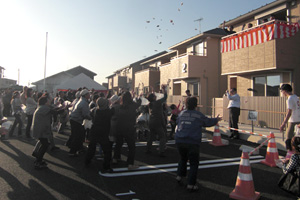
The new residents, neighbors, and Daiwa House staff get together to enjoy a traditional mochi-maki event.
When people are confronted by the realities of life – by the needs and desires of people who are suffering – they can find the strength to keep going and overcome obstacles. This is what happened to Hiroyuki Ishii. Because he kept on listening to the people he had been sent to help, he was highly motivated, and found the determination to do everything he could for them.
"Going forward", says Mr. Ishii, "I would like to analyze how it is that we were able to overcome all the technical problems involving construction that faced us following the Great East Japan Earthquake. And then I want to pass on this important information to the next generation." A week after he said this, the prefecture of Kumamoto in Kyushu was hit by intensity 7.0 earthquake. No matter where you live in Japan, there is a high probability that your area will experience a major earthquake sooner or later. We at the Daiwa House Group are involved in the business of construction, and thus we can never relax or let down our standards with regard to anti-earthquake measures. All we can do is exert our maximum effort, never forgetting even for a moment that on the fate of a building depend the lives of those who live or work in it.
2016/4/6
* Information on the "Spirit of Hearts" is at the time of the coverage.
-
 "Housing Sales, Sharing in the Joys of Life"
"Housing Sales, Sharing in the Joys of Life"
-
 "Bringing architecture to life"
"Bringing architecture to life"
-
 "A resort hotel that fosters connections"
"A resort hotel that fosters connections"
-
 "A Free Hand to Design a New World of Luxury Houses"
"A Free Hand to Design a New World of Luxury Houses"
-
 "The next mission in construction business"
"The next mission in construction business"
-
 "An Athlete’s Flying Start to His Second Life"
"An Athlete’s Flying Start to His Second Life"
-
 "Tackling the Challenges of Carbon Neutrality"
"Tackling the Challenges of Carbon Neutrality"
-
 "Building Close Relationships with Our Customers"
"Building Close Relationships with Our Customers"
-
 "Transforming the Construction Sector with DX"
"Transforming the Construction Sector with DX"
-
 "Bringing Ever-More Joy to Travel in Japan"
"Bringing Ever-More Joy to Travel in Japan"
-
 "Regeneration" Arises from New Construction
"Regeneration" Arises from New Construction
-
 "An Enduring Spirit of Hospitality"
"An Enduring Spirit of Hospitality"
-
 "Collaborating with 16 creators invited from around the world"
"Collaborating with 16 creators invited from around the world"
-
 "Passing Down Hometown to Future Generations with Renewable Energy"
"Passing Down Hometown to Future Generations with Renewable Energy"
-
 "The twenty-first century will be wind, solar, and hydro"
"The twenty-first century will be wind, solar, and hydro"
-
 "Be a Pioneer in the Design Revolution"
"Be a Pioneer in the Design Revolution"
-
 "Building better places to live through partnership between the public and private sectors"
"Building better places to live through partnership between the public and private sectors"
-
 "Supporting the foundations of the nation"
"Supporting the foundations of the nation"
-
 "Continuing to work the rest of life"
"Continuing to work the rest of life"
-
 "Doing our best to support post-disaster reconstruction"
"Doing our best to support post-disaster reconstruction"
-
 "Defying common wisdom in housing construction"
"Defying common wisdom in housing construction"
-
 "Develop the American market!"
"Develop the American market!"
-
 "Exporting Japanese industrial parks"
"Exporting Japanese industrial parks"
-
 "Industrializing agriculture"
"Industrializing agriculture"

